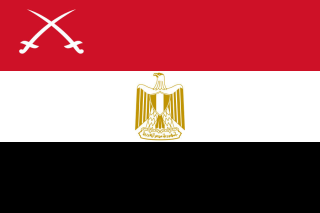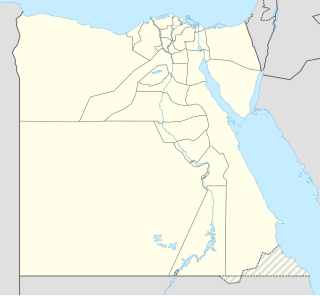 W
WThe Egyptian Armed Forces are the state military organisation responsible for the defense of Egypt. They consist of the Egyptian Army, Egyptian Navy, Egyptian Air Force and Egyptian Air Defense Forces.
 W
WEgypt had a history of weapons of mass destruction and used chemical weapons during the North Yemen Civil War. Although it has signed the Nuclear Non-Proliferation Treaty, it still remains one of only four countries not to ratify the Chemical Weapons Convention and has not ratified the Biological Weapons Convention.
 W
WThe Egyptian Air Defense Forces or EADF, is the Anti-aircraft warfare branch of the Egyptian Armed Forces. It is responsible for protecting the Egyptian airspace against any hostile air attacks. The EADF was established in accordance with the presidential decree issued on 1 February 1968, which provided for the establishment of the Air Defense Forces as the fourth branch, next to the Navy, Egyptian Ground Forces, and Egyptian Air Force, formerly part of the artillery and under the operation command of the Air Force. Egypt has a modern system of air defense armament, characterized by diverse sources between east and west, which is divided between anti-aircraft missiles long, medium and short-range anti-aircraft artillery systems and early warning radars.
 W
WThe Egyptian Army or Egyptian Ground Forces is the largest service branch within the Egyptian Armed Forces. The modern army was established during the reign of Muhammad Ali Pasha (1805–1849), widely considered to be the "founder of modern Egypt". Its most significant engagements in the 20th century were in Egypt's five wars with the State of Israel, one of which, the Suez Crisis of 1956, also saw it do combat with the armies of Britain, and France. The Egyptian army was also engaged heavily in the protracted North Yemen Civil War, and the brief Libyan-Egyptian War in July 1977. Its last major engagement was Operation Desert Storm, the liberation of Kuwait from Iraqi occupation in 1991, in which the Egyptian army constituted the second-largest contingent of the allied forces.
 W
WThe Egyptian Navy, also known as the Egyptian Naval Force, is the maritime branch of the Egyptian Armed Forces. It is the largest navy in the Middle East and Africa, and is the sixth largest in the world measured by the number of vessels. The navy's missions include protection of more than 2,000 kilometers of coastline of the Mediterranean Sea and the Red Sea, defense of approaches to the Suez Canal, and support for army operations. The majority of the modern Egyptian Navy was created with the help of the Soviet Union in the 1960s. The navy received ships in the 1980s from China and other, western, sources. In 1989, the Egyptian Navy had 18,000 personnel as well as 2,000 personnel in the Coast Guard.
 W
WBallistic missile test and launch facility was built in the late 1950s and it is the oldest functioning ballistic missile installation in the developing world, located near Jabal Hamzah 62 kilometres (39 mi) west-northwest of Cairo.
 W
WThe Egyptian Ministry of Defense and Military Production is the ministry responsible for the Egyptian Armed Forces organization and manages its affairs and maintains its facilities. It also handles the affairs of colleges and military recruitment, mobilization and management of veterans and military factories in Egypt through the Armed Forces Management and Administration Agency. The ministry is based in Cairo.
 W
WOperation Eagle was an Egyptian military campaign in the Sinai Peninsula, that was launched in August, 2011 to confront the Sinai insurgency. The campaign was aimed against Islamist insurgents, who had been attacking the Egyptian security forces in the Sinai and using the area as a base from which to attack Israel since early 2011. Successive Egyptian operation against insurgents in 2012, named Operation Sinai, was initially referred as the second part of Operation Eagle. It was the first in a number of campaigns to retake the Sinai from insurgents that lasts to this day.
 W
WOperation Sinai is an ongoing Egyptian military campaign, launched in early August 2012, against Islamic militants within the Sinai Peninsula to crush the Sinai Insurgency. The operation came as a direct response to the 2012 Egyptian-Israeli border attack on 5 August 2012. The operation was initially reported as part of "Operation Nisr", but on 3 September 2012, the Egyptian army issued a statement requesting media sources to use the official name "Operation Sinai."
 W
WRassmna A'la Al-Qlb Wagh Al-Watan is the anthem of the Egyptian Armed Forces. The Lyrics were written by Farouk Gouida and composed by Kamal Al-Taweel.
 W
WThe Supreme Council of the Armed Forces is a statutory body of between 20 and 25 senior Egyptian military officers and is headed by Field Marshal Abdul Fatah al-Sisi and Lieutenant General Mohamed Ahmed Zaki. The council is convened only in cases of war or great internal emergencies. As a consequence of the Egyptian Revolution of 2011, SCAF assumed power to govern Egypt from departing President Hosni Mubarak on 11 February 2011, and relinquished power on 30 June 2012 upon the start of Mohamed Morsi's term as president.